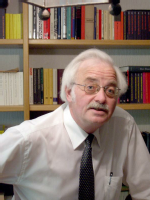Keynote Speaker: Prof Walter Schubert
Simultaneous 100-parameter imaging and real time slicing across thousands of protein clusters in a single diagnostic tissue section using TISTM technology at 40nm super-resolution: the human toponome project
Walter Schubert1,2,3
1Human Toponome Project (www.huto.toposnomos.com)
2International faculty, Max-Planck (CAS-MPG) Partner Institute of Computational Biology, Shanghai, China
3Molecular Pattern Recognition Research (MPRR) Group, Unoversiry of Magdeburg, Germany
 Abstract: The recent development of parameter-unlimited super-resolution microscopy TISTM(Toponome Imaging System) provides direct access to protein neworks at nanometer 2D and 3D resolution in a single tissue section (www.huto.toposnomos.com). TISTM is a device that overcomes both the spectral and the resolving power of a conventional light microscopy without having to change hardware. It is the first ready-to-use technology for dimension- and parameter-unlimited histological diagnostics and systematic decoding of the toponome at super-resolution (toponome: defined as the spatial protein network code in morphologically intact cells and tissues). TISTM is a highly flexible machine that can adapt to the needs of the researcher: a 4-in-one microscope including (1) routine transmitted light functions, (2) conventional fluorescence functionalities, (3) paramater-unlimited protein network visualization in real time, and (4) super-resolution of subcellular structures and protein clusters in tissue sections and in cultured cells (subnanometer to 40nm resolution). It is a novel platform providing the robustness needed for the human toponome project, combining industry partners and research institutions. The technology has shown to solve key problems in cell-, tissue-, and clinical toponomics by directly decoding cellular (disease) mechanisms in situ/in vivo. Several next-generation toponome biomarkers and toponome drugs are on the way to clinic. The human toponome project has at its goal to unravel the complete toponome in all cell types and tissues in health and disease. The technology is scalable as large cooperative parallel screening devices extracting the most relevant disease targets from protein network hierarchies in situ: a novel efficient way to find selective drugs, by escaping the low content trap in drug target and diagnostic marker discovery (Ref: e.g. Nat Biotechnol 2006, Nat Protoc 2007, N. Biotechnol 2011).
Abstract: The recent development of parameter-unlimited super-resolution microscopy TISTM(Toponome Imaging System) provides direct access to protein neworks at nanometer 2D and 3D resolution in a single tissue section (www.huto.toposnomos.com). TISTM is a device that overcomes both the spectral and the resolving power of a conventional light microscopy without having to change hardware. It is the first ready-to-use technology for dimension- and parameter-unlimited histological diagnostics and systematic decoding of the toponome at super-resolution (toponome: defined as the spatial protein network code in morphologically intact cells and tissues). TISTM is a highly flexible machine that can adapt to the needs of the researcher: a 4-in-one microscope including (1) routine transmitted light functions, (2) conventional fluorescence functionalities, (3) paramater-unlimited protein network visualization in real time, and (4) super-resolution of subcellular structures and protein clusters in tissue sections and in cultured cells (subnanometer to 40nm resolution). It is a novel platform providing the robustness needed for the human toponome project, combining industry partners and research institutions. The technology has shown to solve key problems in cell-, tissue-, and clinical toponomics by directly decoding cellular (disease) mechanisms in situ/in vivo. Several next-generation toponome biomarkers and toponome drugs are on the way to clinic. The human toponome project has at its goal to unravel the complete toponome in all cell types and tissues in health and disease. The technology is scalable as large cooperative parallel screening devices extracting the most relevant disease targets from protein network hierarchies in situ: a novel efficient way to find selective drugs, by escaping the low content trap in drug target and diagnostic marker discovery (Ref: e.g. Nat Biotechnol 2006, Nat Protoc 2007, N. Biotechnol 2011).
Biography
Walter Schubert is head of the Molecular Pattern Recognition Research (MPRR) group at the Medical Faculty of the Otto-von-Guericke-University, Magdeburg, Germany, and guest Professor for Toponomics at the Max-Planck-CAS (CAS-MPG) partner Institute for computational biology, Shanghai, China. Walter Schubert has studied medicine at the universities of Aachen and Bonn, Germany, and has led the neuromuscular diagnostic center at the university of Bonn. He has invented and developed during his clinical work the toponome imaging robot technology MELC/TIS in 1990 (to decipher the protein networks in humans), is co-initiator of the course of studies in computervisualistics (CV) at Magdeburg university (MDU), and teaches human biology for students in CV and medicine at the MDU. Walter Schubert holds many patents, has received several national and international awards and honours, such as the american ISAC best paper award 2008 (for the three symbol code of organized proteomes, “toponome”), and has launched the human toponome project aiming at the functional decoding of the protein networks in humans.
He is keynote speaker at international congresses (presenting the human toponome project), invited distinguished lecturer at the Case Western Reserve University (2010), and member of several american and european editorial and scientific advisory boards. WS chaired three interdisciplinary national joint projects of the Deutsche Forschungsgemeinschaft and the BMBF (at MDU, and transnational) connecting engineering, informatics, medicine and cell biology in the field of toponomics. The work of the his Magdeburg group and coworkers has been acknowledged by a Research Highlight “Mapping togetherness” (Nature 443, p 609, 2006).
